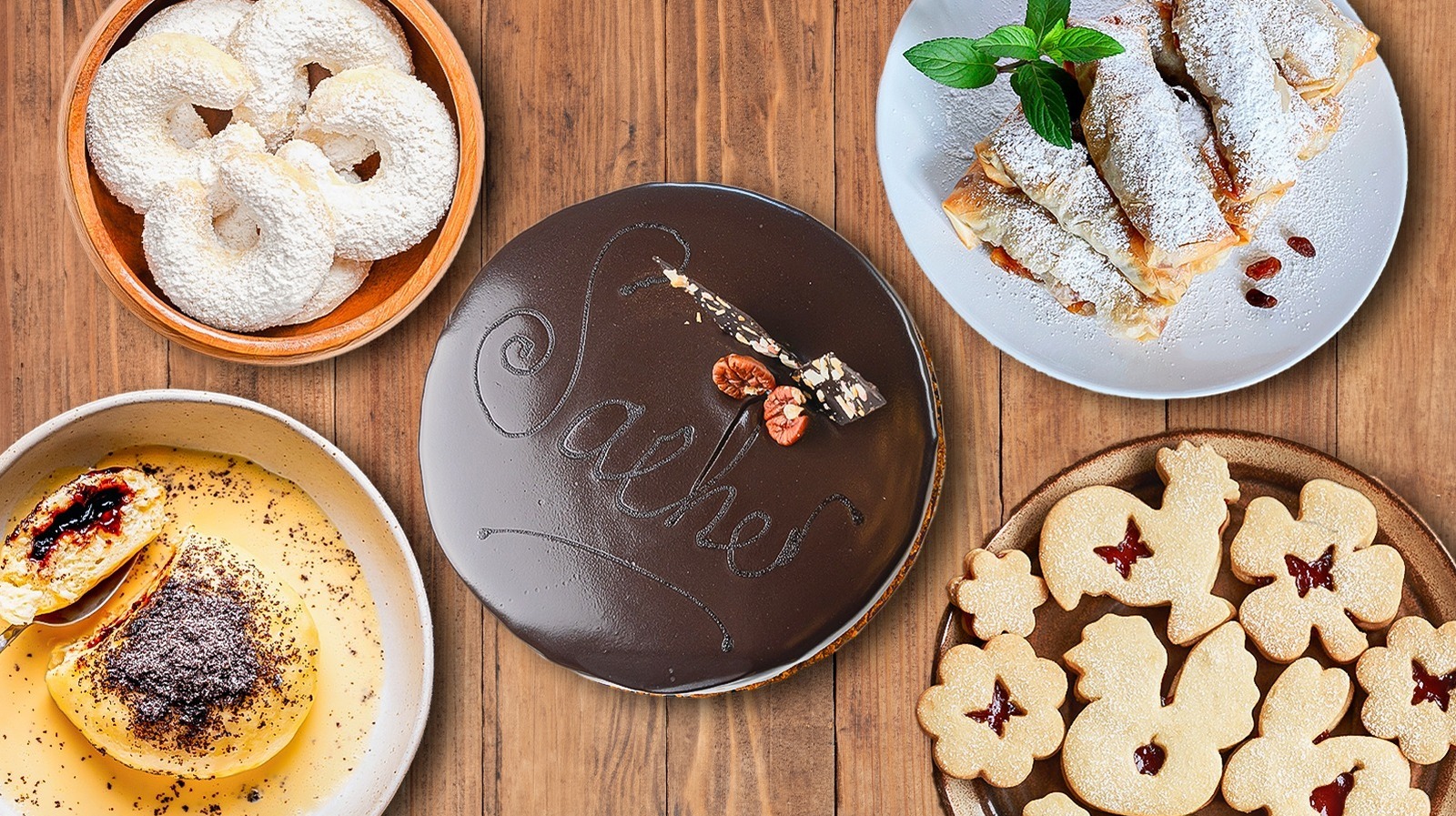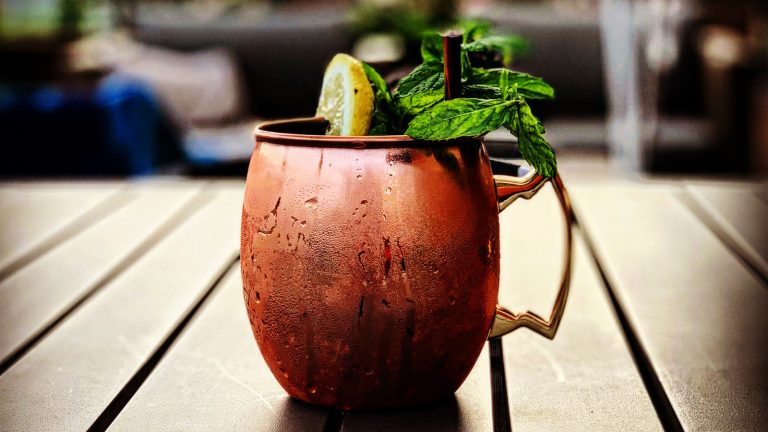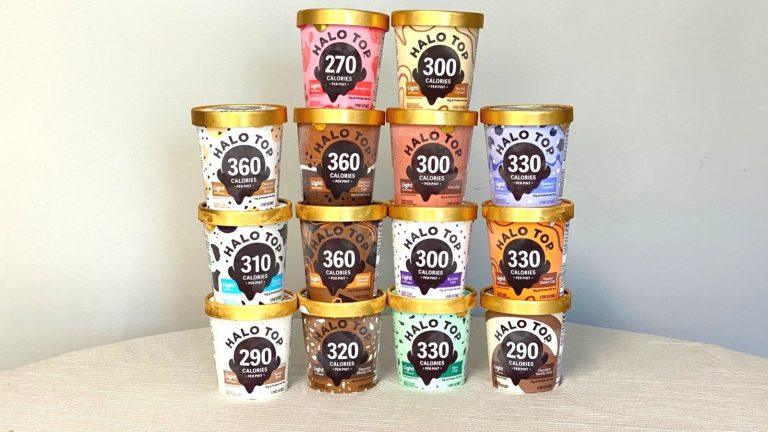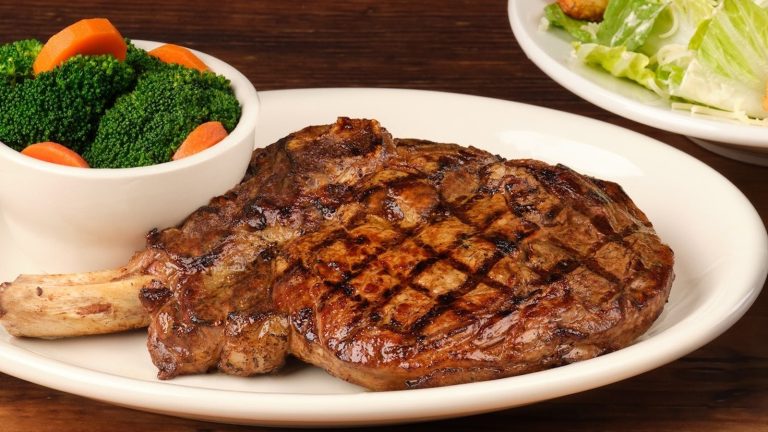We may receive a commission on purchases made from links.
Austrian and German cuisines often get lumped together due to the two countries’ shared heritage. However, this does a disservice to all the cookies, cakes, strudels, dumplings, donuts, tortes, pancakes, and rolls that Austrian chefs have been perfecting for centuries. We have curated this list to introduce you to some of our favorite Austrian desserts. Some of them you may have seen before — most likely around the holiday season — but some will probably be brand new to you.
You’ll find that Austrian desserts make heavy use of jams and fruit preserves and tend to be less overwhelmingly sweet than American desserts. They also frequently call for butter, milk, sugar, flour, and quark cheese (more on that later). Additionally, Austrians like to get their caffeine fix and satisfy their sweet tooth at the same time. That is to say, most of these desserts pair splendidly with coffee and can be served mid-afternoon. Even so, some of them can be served as meals rather than just desserts, usually for breakfast or lunch. Whenever and however you eat these delicacies, you’re in for a sweet treat!
Vanillekipferl
Vanillekipferl are crescent-shaped cookies that are a staple in many Austrian and German households during the weeks leading up to Christmas. Small in size, they are the perfect choice when you just want a mid-afternoon pick-me-up or a cookie to accompany your coffee. Similar to Mexican wedding cookies, vanillekipferl recipes call for a hefty amount of butter, plus ground almonds, flour, and sugar. Many recipes mandate two types of sugar: Vanilla sugar and powdered sugar. The former is a variety of sugar often used in Austrian baking, but if needed, vanilla extract can be used instead, as long as the recipe is adjusted to reflect the additional liquid content.
Once the dough has been combined and allowed to rest, it is rolled into a thin log, sliced into pieces, and shaped into crescents. The cookies are then baked before finally being coated in powdered sugar. This process results in shortbread cookies with a craveable melt-in-your-mouth texture. Indeed, it’s hard to stop at just one cookie! If you can practice a bit of self-restraint, though, vanillekipferl can be stored in an airtight tin for three to four weeks.
Sachertorte
Sachertorte has gained international fame thanks to its delicate layers of apricot jam and dark chocolate glaze. Traditional recipes call for very few ingredients, so it is important to use fresh vanilla bean and high-quality chocolate and butter. You can try the cake at Demel, one of the best restaurants in Vienna, or at Hotel Sacher, which supposedly serves the original version created by Franz Sacher.
Sachertorte is one of those desserts that evoke a distinct sense of pride in Austrians, who tend to serve it on celebratory occasions like birthdays. It has been around since the 1800s, and while its original recipe is carefully guarded, most versions taste similar to one another and forgo the addition of any unnecessary bells and whistles. The only exception is the dollop of unsweetened whipped cream and the piece of chocolate that often adorns each slice of torte. Additionally, if you are indulging in a slice of this classic in Vienna, it is customary to order it alongside a cup of coffee, particularly the Viennese melange.
Germknödel
Head to the dining hall of any Austrian ski resort, and you will probably find the massive dumplings known as germknödel being served to ravenous skiers. While this dessert is certainly a cold weather staple, you can find it year-round in the frozen section at Austrian grocery stores. Of course, you can always make your own at home, provided you have the right ingredients.
Germknödel is stuffed with powidl, a unique plum preserve that is reduced over the stove and forgoes the use of sugar. If you can’t find powidl, try sourcing plum jam and adding a few flavoring agents like star anise, cloves, cinnamon, vanilla bean, lemon zest, and rum. Additionally, you will need ingredients like flour, eggs, milk, butter, sugar, vanilla, and yeast for the dough, as well as poppy seeds, powdered sugar, and either melted butter or vanilla sauce for serving. Since these are yeast dumplings, be sure to plan ahead and leave time for the dough to proof. Once the dumplings have sufficiently rested, they should be steamed or boiled, allowing the dough to expand slightly and attain its signature fluffy texture.
Krapfen
You won’t find krapfen in your local Krispy Kreme, but the chain’s jam-filled donuts are somewhat similar to this Austrian specialty that has been around for centuries. Krapfen are pillowy soft, filled with apricot jam (or occasionally vanilla custard), and showered in powdered sugar. These donuts are especially abundant during the carnival season and on Fat Tuesday, but they can be enjoyed any time of the year.
Making your own krapfen at home might seem like an intimidating endeavor, but with a bit of preparation and patience, you’ll find that the process is actually quite simple. Krapfen dough consists of basic ingredients like sugar, milk, butter, eggs, flour, vanilla, and sometimes rum. The dough also contains yeast, so after cutting it into rounds, allow the dough to rest for up to an hour or so. Next up comes frying: Here, you should cover the pan with a lid so that the donuts can continue to rise and take on a distinctive white ring around their circumference. Make sure to flip the donuts so that each side browns beautifully. Once cool, the jam can be piped into the donuts. We suggest investing in a pastry bag to reduce messiness.
Topfenstrudel
If the only kind of cheesy dessert you have ever eaten is cheesecake, then it’s time to try topfenstrudel. This dessert stars quark, a soft, fresh, and neutral cheese that is somewhere between yogurt and cottage cheese and is readily available in Austrian grocery stores. In addition to topfenstrudel, quark cheese can be found in Austrian cheesecake and as a part of a classic breakfast spread. In the United States, head to your local Whole Foods for the best chance of finding a tub of this tangy cheese.
The dough is typically composed of more familiar ingredients, such as flour, salt, water, and a fat like vegetable oil. The strudel layer must be sturdy enough to accommodate the filling, which is thickened by eggs and ingredients like semolina flour and custard powder. Using quark with a lower ratio of water can also help bulk up the filling. Raisins, lemon zest, and fresh vanilla bean powder help brighten up the flavors of topfenstrudel, and the dessert is frequently served with a ladleful of custard to provide a complementary texture and an extra dose of sweetness.
Topfenknödel
Topfenknödel is another cheese-based dessert, but this time in a dumpling form. Though recipes vary, the dumplings are usually made with ingredients such as semolina flour, butter, eggs, sugar, salt, breadcrumbs, and a few flavoring ingredients like cinnamon, vanilla, and lemon zest. They are simmered in water for approximately 10 minutes and are then coated in a mix of sugar and breadcrumbs that provides a beautiful textural contrast to the soft center. Additionally, the breadcrumbs can be lightly toasted in butter beforehand. These dumplings can be served with applesauce or fruit preserves, such as apricot, plum, or strawberry. Mint leaves are occasionally used for garnish, and you might find topfenknödel served with fresh strawberries.
Though topfenknödel have Bohemian origins, they are now considered to be a quintessential Austrian dessert that can be served at the end of a meal or as a meal on its own. Designed to be eaten in one or two bites, topfenknödel are not overwhelmingly sweet, so you can easily enjoy several in one sitting.
Marillenkuchen
After trying your share of Austrian desserts, you will find that apricot is a common ingredient. The apricot season starts in July, and during this time, it is easy to source the fruits directly from farmers. So, it only makes sense that an entire cake should revolve around apricots, complementing the distinct apricot flavors with ingredients like lemon zest, vanilla, and powdered sugar, all incorporated in a lightly sweetened cake batter.
Marillenkuchen is a gorgeous cake to behold. Instead of being chopped and stirred into the cake, apricots are sliced and arranged on top of the batter before the cake is placed in the oven. Because marillenkuchen is a light, airy sponge cake, the batter envelops the edges of each apricot slice as it rises. Finally, an apricot jam glaze can be added for a glossy, sweet finish. The end result is a soft, juicy dessert with distinct textures and flavors in each bite.
Apfelstrudel
Indisputably one of Austria’s most famous desserts, apfelstrudel has held a place in the country’s culinary repertoire since at least the 17th century, when a cookbook author penned an early recipe for the dish by hand. Over the course of the next century, apfelstrudel stole the hearts of Vienna’s aristocracy, and in 1827, Anna Dorn documented a more modern version of it in the Great Viennese Cookbook. Today, several variations of apfelstrudel exist, but each recipe will invariably include apples and a pastry.
Apfelstrudel has elements of Turkish baklava, but it will also remind you of a warm, gooey apple pie. The pastry used for making apfelstrudel is usually the simple unleavened strudel dough that is rolled thin — store-bought varieties also work well — but puff pastry is also occasionally used. For the best results, choose an apple variety like Golden Delicious. Apfelstrudel can be eaten as a dessert or as a full-fledged meal. Indeed, the pastry is often present on breakfast menus and pairs wonderfully with a cappuccino. It can be topped with whipped cream or vanilla ice cream, while the addition of raisins brings apfelstrudel to a whole new level.
Kaiserschmarrn
Kaiserschmarnn is one of the world’s most delicious pancake dishes, and it holds a special place for many Austrians, bringing up fond memories of Christmas markets and ski seasons. This national treasure is generally believed to have originated when Emperor Franz Josef I was in power between 1848 and 1916. Indeed, “kaiserschmarnn” translates to “emperor’s mess,” though what exactly the emperor had to do with scrambled pancakes is up for debate.
Decadent kaiserschmarnn recipes frequently ask cooks to whip the egg whites separately to create the signature airy texture, and they also suggest sauteing raisins in butter — sometimes with a dash of Grand Marnier or rum – before adding the batter. These pancakes can be made on the stove or in the oven, and once they have cooked through, they are chopped into pieces with two forks. Finally, the pieces are coated in powdered sugar and tossed around the pan so that the sugar caramelizes. As opposed to the maple syrup drenched affair enjoyed in the United States, kaiserschmarnn are usually served with a saucy condiment on the side, such as chocolate, fruit compote, applesauce, or roasted plums.
Palatschinken
Palatschinken are the Austrian version of crêpes, but don’t make the mistake of equating these two dishes. Thicker than French crêpes, palatschinken are spread with fillings like apricot jam, Nutella, apples and cinnamon, or quark cheese and are swirled into individual rolls. If you are ordering palatschinken with apricot jam, note that it might be spiked with brandy, depending on the restaurant. Each plate of lightly browned palatschinken is served with a generous sprinkling of powdered sugar and perhaps some whipped cream for flavor and aesthetic.
These thin pancakes are easy to prepare at home as they require staple ingredients like flour, eggs, milk, salt, and perhaps butter and/or vanilla sugar. Interestingly, the addition of sparkling water can help make palatschinken fluffier. If you are not in the mood for dessert, you can opt for savory fillings like cheese, tomatoes, spinach, or ham. After all, palatschinken typically makes an appearance during lunch time and can constitute an entire meal.
Buchteln
While relatively simple in form and ingredients, it is easy to fall in love with buchteln (also known as wuchteln), one of the world’s most unique pastries. Each one of these mildly sweet rolls hides a generous dab of apricot jam in the center. The dough generally consists of flour, salt, milk, eggs, butter, vanilla, sugar, and yeast, and has to be proofed to attain its signature texture. Before being placed in the oven, each buchtel is brushed generously with butter and packed tightly into a baking tray with the other rolls. Because these are yeasted rolls, the dough expands beautifully around the jam. The pull-apart nature of these rolls makes them a wonderful choice for family meals.
Buchteln achieve another level of dessert perfection when served with vanilla sauce, though this is not required, but powdered sugar also adds a nice touch. When served hot, the soft, airy dough is perfectly complemented by the crispy crust. No matter what, try to finish your rolls within a day or two before they lose their pillowy texture.
Linzer torte
Odds are high that you have seen Linzer or spitzbuben cookies in a bakery before, particularly around the holiday season. These jam-filled cookies are perfect for when you want a light dessert. Linzer torte, on the other hand, is an Austrian tart less commonly found in the United States, yet it shares much in common with its cookie counterpart. Head to the city of Linz to taste the original recipe, as the tart has been familiar since at least the 1600s. Otherwise, prepare it at home as the process is relatively simple.
Baked until golden brown and dusted with powdered sugar, Linzer torte is an ideal centerpiece for your holiday dessert table. The dough of this tart is infused with a generous amount of butter, as well as a lovely nutty flavor, usually from almonds or hazelnuts. Once you slice through its lattice crust, your tastebuds will be delighted with a thick layer of tart berry jam, which perfectly contrasts and complements the sweet, buttery crust. While red currant and black currant jam are traditional, you can also pick variations like raspberry or mixed berry jam to fill your tart.
Linzer cookies
If you are a fan of thumbprint cookies, then Linzer cookies will win your heart with their tart fillings and nutty flavor. Derived from Linzer torte, these cookies traditionally feature red currant or black currant jam sandwiched inside two layers of buttery, nut-infused dough. Shapes like hearts and stars are punched out of the top layer to reveal the jam underneath, and a dusting of powdered sugar gives the cookies an extra aesthetic touch. Linzer torte and Linzer cookies are so similar that you can use leftover dough from the former to make the latter.
Don’t hesitate to use a different jam, such as raspberry jam or strawberry jam, inside your cookies for a fun variation; bold red jams are particularly festive. You should also invest in a Linzer cookie cutter set to achieve maximum uniformity and crisply cut edges. Finally, splurge on fancy butter with a high fat content; not only will this help the cookies retain their structural integrity while baking, but because butter is such a prominent ingredient in Linzer cookies, you will be able to tell a difference in taste as well.
Cremeschnitte
A creamy, vanilla-based custard steals the show in cremeschnitte. This cream cake is beloved for its contrasting textures and sweet vanilla flavor. Cremeschnitte is a rather straightforward dessert. It consists of two sheets of puff pastry and a thick layer of custard in the center. Though less traditional, thickened vanilla pudding can also be used. There are a handful of variations of the dessert around Europe, and the Austrian version is generally served sliced in rectangles or squares dusted with powdered sugar.
To make cremeschnitte, you will need to prepare or buy puff pastry and bake it until golden and crispy. While the shell is in the oven, you can make the custard with sugar, milk, eggs, vanilla, butter, and heavy cream. Finally, you will need to spread the custard between the two layers of puff pastry and allow it to set in the refrigerator for several hours. In fact, you can keep cremeschnitte in the refrigerator for a few days, but be mindful that the puff pastry will get soggy with time.
Malakofftorte
Malakofftorte may be a mouthful to say, but it’s worth overcoming the linguistic challenge to taste just one mouthful of this torte. Though malakofftorte doesn’t have Austrian roots, it can now be widely found in Viennese cafes and pastry shops. A typical recipe requires ladyfingers, a type of cookie with a subtle flavor and an incredibly delicate and airy texture. The ladyfingers are dipped in syrup and layered with a light and creamy filling. Finally, the torte is garnished with more ladyfingers (these ones dipped in chocolate), as well as whipped cream and toasted almonds.
Recipes for malakofftorte vary widely and can get quite creative. For instance, chocolate, fruits, and liqueurs can be incorporated into the torte. While whipped cream is more commonly used in modern recipes, mousseline cream (a combination of whipped butter and pastry cream) was previously preferred by bakers. The multiple layers of this torte offer a good introduction to understanding the difference between tortes and cakes.





